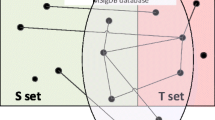Abstract
Broad and extensive knowledge of the biological function of proteins would have great practical impact on the identification of novel drug targets, and on finding the molecular causes of diseases. The experimental in vitro determination of protein function is an expensive and time consuming process. As a consequence, the development of computational techniques to complement and guide the experimental process is a crucial step for biological analysis in the post-genomic era. The prediction of molecular interactions is an important component in functional annotation Here we shortly describe two approaches to tackle this problem. One approach is structure-based and consists of identifying possible regions of interface on the surface of proteins. A second approach is to transfer a reliable interaction from a species to another species when both species are represented by networks of experimentally determined interactions.
Access this chapter
Tax calculation will be finalised at checkout
Purchases are for personal use only
Preview
Unable to display preview. Download preview PDF.
Similar content being viewed by others
References
Angaran, S., Bock, M.E., Garutti, C., Guerra, C.: MolLoc: a web tool for the local alignment of molecular surfaces. Nucleic Acids Research (2009), doi:10.1093/NAR/GKP405
Bock, M.E., Garutti, C., Guerra, C.: Discovery of similar regions on protein surfaces. Journal of Computational Biology 14(3), 285–299 (2007)
Bock, M.E., Garutti, C., Guerra, C.: Cavity detection and Binding site recognition in proteins. Theoretical Computer Science (2008), doi:doi:10.1016/j
Cannataro, M., Ciriello, G., Guerra, C., Guzzi, P., Mina, M.: AlignNemo: a novel method to align PPI networks (manuscript)
Comin, M., Dellaert, F., Guerra, C.: Binding Balls: Fast detection of binding sites using a property of Spherical Fourier Transform. Journal of Computational Biology 16 (2009), doi:10.1089/cmb.2009.0045
Glaser, F., Morris, R.J., Najmanovich, R.J., Laskowski, A., Thornton, J.M.: A method for localizing ligand binding pockets in protein structures. Proteins: Struct. Funct. Bioinf. 62, 479–488 (2006)
Kelley, B.P., et al.: Conserved pathways within bacteria and yeast as revealed by global protein network alignment. Proc. Natl. Acad. Sci. USA 100, 11394–11399 (2003)
Kinoshita, N., Furui, J., Nakamura, H.: Identification of protein functions from a molecular surface database, eF-site. J. Struct. Funct. Genomics 2, 9–22 (2001)
Koyuturk, M., et al.: Pairwise alignment of protein interaction networks. J. Comput. Biol. 13, 182–199 (2006)
Morris, R.J., Najmanovich, R.J., Kahraman, A., Thornton, J.M.: Real spherical harmonic expansion coefficients as 3D shape descriptors for protein binding pocket and ligand comparison. Bioinformatics 21(10), 2347–2355 (2005)
Newman, M.E.J.: The structure and function of complex networks. SIAM Rev. 45(2), 167–256 (2003)
Shen-Orr, S.S., Milo, R., Mangan, S., et al.: Network motifs in the transcriptional regulation network of Escherichia coli. Nat. Genet. 31, 64–68 (2002)
Shulman-Peleg, A., Nussinov, R., Wolfson, H.J.: Recognition of functional sites in protein structures. J. Mol. Biol. 339, 607–633 (2004)
Singh, R., Xu, J., Berger, B.: Pairwise global alignment of protein interaction networks by matching neighborhood topology. In: Speed, T., Huang, H. (eds.) RECOMB 2007. LNCS (LNBI), vol. 4453, pp. 16–31. Springer, Heidelberg (2007)
Sommer, I., Miller, O., Domingues, F., Sander, O., Weickert, J., Lengauer, T.: Moment invariants as shape recognition technique for comparing protein binding sites. Bioinformatics 23, 3139–3146 (2007)
Yao, H., Kristensen, D.M., Mihalek, I., Sowa, M.E., Shaw, C., Kimme, M., Kavraki, L., Lichtarge, O.: An accurate, sensitive, and scalable method to identify functional sites in protein structures. J. Mol. Biol. 326, 255–261 (2003)
Author information
Authors and Affiliations
Editor information
Editors and Affiliations
Rights and permissions
Copyright information
© 2011 Springer-Verlag Berlin Heidelberg
About this paper
Cite this paper
Guerra, C., Mina, M. (2011). Computational Methods for the Prediction of Protein-Protein Interactions. In: Aggarwal, J.K., Barneva, R.P., Brimkov, V.E., Koroutchev, K.N., Korutcheva, E.R. (eds) Combinatorial Image Analysis. IWCIA 2011. Lecture Notes in Computer Science, vol 6636. Springer, Berlin, Heidelberg. https://doi.org/10.1007/978-3-642-21073-0_4
Download citation
DOI: https://doi.org/10.1007/978-3-642-21073-0_4
Publisher Name: Springer, Berlin, Heidelberg
Print ISBN: 978-3-642-21072-3
Online ISBN: 978-3-642-21073-0
eBook Packages: Computer ScienceComputer Science (R0)




